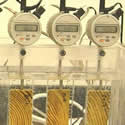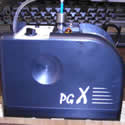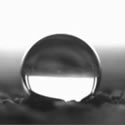Laboratory Water Repellency Tests
An increasingly important area of wood protection development focuses on the appearance of wood products in service. Materials in service are subjected to biodeteriogens, such as fungi and insect attack, and test methods for these are covered elsewhere on this site, but are also subjected to phsyical damage through weathering effects caused by exposure to sunlight and moisture content changes from water exposure such as from rain events. Laboratory methods for exposure include the use of weathering devices such as the Weatherometer®and QUV® instruments.
For studying the impact of exposure of wood materials to liquid water, the most widely used method is the Swellometer test. This method usually involves the study of tangential swelling of wood with time using dial gauges. These days digital gauges are used with data recorded continuously in increments as short as every second and often this is continued until maximum swelling of the samples is achieved. These tests can be carried out in parallel using multiple test arrangements to provide excellent comparative data of materials and/or treatments' performance.
Versions of the swellometer test are standardized by ASTM (as Standard D4446), and the AWPA (as Standard E4) although the WDMA TM-2 test method is commonly used.
Other methods of measuring moisture ingress into wood include gravimetric determinations of water uptake over time, as well as contact angle changes of surface applied water droplets, the latter methodology now being able to be carried out with digital devices with signal output for data collection. One such alternative method is embodied in AWPA Standard E13.
Images
References


